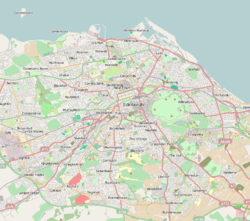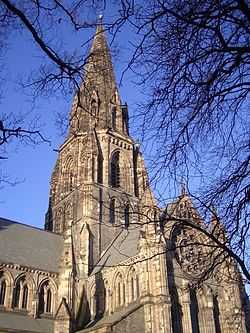St Mary's Cathedral, Edinburgh (Episcopal)
| Saint Mary's Cathedral, Edinburgh | |
|---|---|
| Cathedral Church of Saint Mary the Virgin | |
|
The central spire of St Mary's Cathedral | |
 Saint Mary's Cathedral, Edinburgh Location within Edinburgh | |
| Coordinates: 55°56′55″N 3°12′58″W / 55.94861°N 3.21611°W | |
| Denomination | Scottish Episcopal Church |
| Churchmanship | Broad Church |
| Website | www.cathedral.net |
| History | |
| Dedication | St Mary the Virgin |
| Administration | |
| Diocese | Edinburgh |
| Clergy | |
| Bishop(s) | The Rt Rev. Dr. John Armes |
| Provost | The Very Rev. Graham Forbes CBE |
| Precentor | Canon Peter Allen |
| Laity | |
| Organist(s) | Duncan Ferguson |
St Mary's Cathedral or the Cathedral Church of Saint Mary the Virgin is a cathedral of the Scottish Episcopal Church in Edinburgh, Scotland. It was built in the late 19th century in the West End of Edinburgh's New Town. The cathedral is the see of the Bishop of Edinburgh, one of seven bishops within the Episcopal Church, which is part of the Anglican Communion. Designed in a Gothic style by Sir George Gilbert Scott, the cathedral is now protected as a category A listed building.[1]
History
In 1689, following the Glorious Revolution, Presbyterianism was restored in place of episcopacy in the national Church of Scotland. St Giles' Cathedral, Edinburgh, as it then was, came under the Established Church's ministry, resulting in Episcopalians being left without a cathedral in Edinburgh. For a time the Episcopal residue of that congregation worshipped in an old woollen mill in Carrubber's Close, near the site of the present Old Saint Paul's Church. This was used as a pro-cathedral until the early 19th century, when this function was served by the Church of St Paul in York Place.
Funding
The original construction was paid for by Barbara and Mary Walker, spinster sisters, providing funds for this purpose from 1873. They owned the surrounding Drumsheugh Estate and lived in Easter Coates House, which still survives to the north of the cathedral. They were the granddaughters of Rev. George Walker, the Episcopal Minister of Old Meldrum Church (1734-1781). Their father, William Walker, was Attorney in Exchequer, and Bearer of the White Rod of Scotland. William Street nearby is named after him. Their mother was Mary Drummond, daughter of George Drummond, six times Lord Provost of Edinburgh and initiator of the New Town.
Design and construction
The cathedral was designed by Sir George Gilbert Scott and the foundation stone was laid on 21 May 1874 by the Duke of Buccleuch and Queensberry, whose family had been supportive of Scottish Episcopacy over the previous hundred years. Inside the stone was placed a bottle containing a copy of the Trust Deed, the Edinburgh Post Office Directory, Oliver and Boyd's Almanac, newspapers and coins. In preparation for the opening of the Cathedral a congregation had been formed to worship in a temporary iron church erected on the site now occupied by the Song School. Beginning on 26 May 1876, it was ministered to by the dean, James Montgomery, and two chaplains, and grew rapidly. The nave of the cathedral was opened on 25 January 1879 and from that day, daily services have been held in the Cathedral. The twin spires at the west end, known as "Barbara" and "Mary" after the Walker sisters, were not begun until 1913 and completed in 1917. The architect for these was Charles Marriott Oldrid Scott, Sir George's grandson. The builder was Edwin C. Morgan.
The reredos is designed by John Oldrid Scott and sculpted by Mary Grant.[2]
Music
St Mary's Cathedral is the only cathedral in Scotland to maintain a tradition of daily choral services with choristers drawn from its own choir school. It was the first cathedral in Britain to employ girls in the treble line as well as boys, in 1978 when Dennis Townhill was organist and choir master. In 2005 St Mary's Cathedral became the first cathedral in the Anglican tradition to have a female alto singing in daily services. The Father Henry Willis organ was built in 1879.
St Mary's Music School was founded to educate its choirboys. It continues to educate choristers of the cathedral and is now a separate specialist music school open to all pupils.
There are ten original bells in the central tower of the Cathedral hung for change ringing, with two further bells being added recently. They were the gift of the first Dean of St Mary's, James F Montgomery. The bells were all cast by John Taylor & Co of Loughborough to weight ratios defined by Lord Grimthorpe who was a leading bell designer of his day. This is one of only a few complete Grimthorpe rings still in existence. The bells were dedicated on 29 October 1879.
Cathedral organists
- 1878 Thomas Henry Collinson
- 1929 Robert Head
- 1958 Eric Parsons
- 1961 Dennis Townhill
- 1991 Timothy Byram-Wigfield
- 1999 Matthew Owens
- 2005 Simon Nieminski
- 2007 Duncan Ferguson
Provosts of the cathedral
- 1879–1897 James Montgomery
- 1897–1919 John Wilson
- 1920–1925 Edward Henderson
- 1925–1938 William Margetson
- 1938–1939 Logie Danson
- 1940–1944 David Dunlop
- 1944–1949 Ivor Ramsay
- 1949–1956 Hector Gooderham
- 1957–1967 Reginald Foskett
- 1967–1970 Patrick Rodger
- 1970–1990 George Crosfield
- 1990–present Graham Forbes
Memorials
- Captain James Dundas V.C. (1842–1879)
- General Sir Alexander Frank Philip Christison Bt. (1893–1993), erected by the Burma Star Association
- Soldiers of the Royal Scots killed overseas 1857–1870
- Reclining marble effigy of James Francis Montgomery (1902) by James Pittendrigh Macgillivray.
The war memorial is by Pilkington Jackson (1920).
Artefacts
Sir Walter Scott's pew was moved here in 2006. It began life in St George's Church on York Place and was then moved in 1932 to St Paul's Church across the road when the two congregations amalgamated, and the latter building became St Paul's and St Georges.
Location
The Cathedral is located between Palmerston Place and Manor Place in the West End of Edinburgh's New Town. "West End - Princes Street" and "Haymarket" are the nearest tram stops served by Edinburgh Trams (opening in 2014).
References
- ↑ "Cathedral Church of St Mary (Episcopal)". Historic Scotland.
- ↑ Dictionary of British Sculptors
External links
| Wikimedia Commons has media related to St Mary's Cathedral, Edinburgh. |
| ||||||||||
